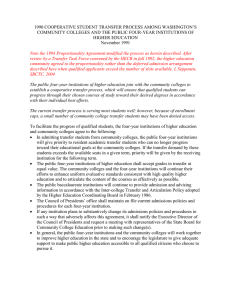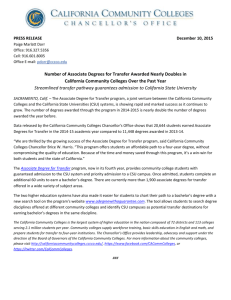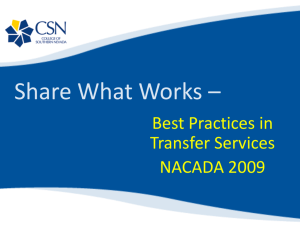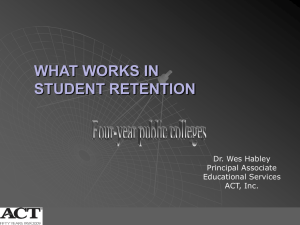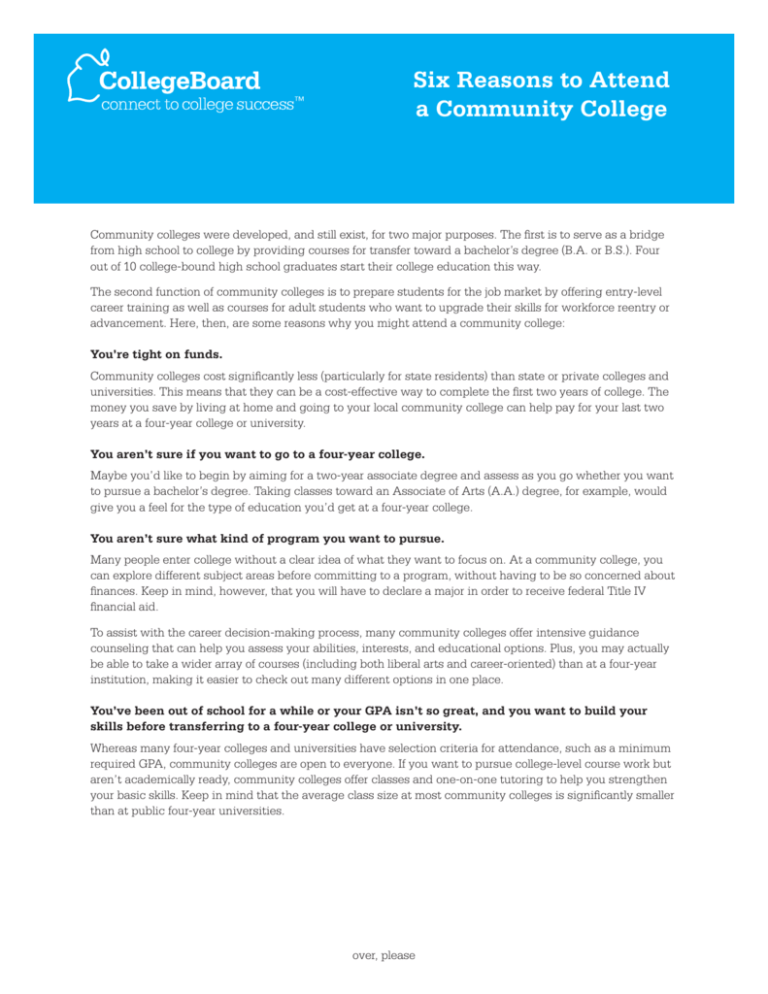
Six Reasons to Attend
a Community College
Community colleges were developed, and still exist, for two major purposes. The first is to serve as a bridge
from high school to college by providing courses for transfer toward a bachelor’s degree (B.A. or B.S.). Four
out of 10 college-bound high school graduates start their college education this way.
The second function of community colleges is to prepare students for the job market by offering entry-level
career training as well as courses for adult students who want to upgrade their skills for workforce reentry or
advancement. Here, then, are some reasons why you might attend a community college:
You’re tight on funds.
Community colleges cost significantly less (particularly for state residents) than state or private colleges and
universities. This means that they can be a cost-effective way to complete the first two years of college. The
money you save by living at home and going to your local community college can help pay for your last two
years at a four-year college or university.
You aren’t sure if you want to go to a four-year college.
Maybe you’d like to begin by aiming for a two-year associate degree and assess as you go whether you want
to pursue a bachelor’s degree. Taking classes toward an Associate of Arts (A.A.) degree, for example, would
give you a feel for the type of education you’d get at a four-year college.
You aren’t sure what kind of program you want to pursue.
Many people enter college without a clear idea of what they want to focus on. At a community college, you
can explore different subject areas before committing to a program, without having to be so concerned about
finances. Keep in mind, however, that you will have to declare a major in order to receive federal Title IV
financial aid.
To assist with the career decision-making process, many community colleges offer intensive guidance
counseling that can help you assess your abilities, interests, and educational options. Plus, you may actually
be able to take a wider array of courses (including both liberal arts and career-oriented) than at a four-year
institution, making it easier to check out many different options in one place.
You’ve been out of school for a while or your GPA isn’t so great, and you want to build your
skills before transferring to a four-year college or university.
Whereas many four-year colleges and universities have selection criteria for attendance, such as a minimum
required GPA, community colleges are open to everyone. If you want to pursue college-level course work but
aren’t academically ready, community colleges offer classes and one-on-one tutoring to help you strengthen
your basic skills. Keep in mind that the average class size at most community colleges is significantly smaller
than at public four-year universities.
over, please
You’d like to undertake a career-oriented degree, such as a fashion-design or computer­certification program.
Programs like these are often not available at four-year institutions. If you’re thinking of seeking employment
after finishing up at community college, there are several routes you can take.
You can earn an associate degree—an Associate in Arts or Science (A.A. or A.S.) or an Associate in Applied
Science (A.A.S.). An A.A.S. usually requires specialized courses in fields such as construction technology,
computer repair, or electronics as well as several general education courses in subjects like English and
math. These degrees take about two years to complete.
However, if you want to take courses in a specialized area of study but don’t want to spend the time necessary to earn an associate degree, many community colleges have certificate options that provide intensive
training in a specialized field like computer-assisted drafting, food-service technology, or paralegal studies.
These certificates usually take six months to a year to complete.
You need to be able to work, perhaps to help support your family, and are seeking a flexible
schedule so that you can work around a job or other commitments.
At four-year colleges, course schedules are geared primarily toward full-time, traditional students who take
classes during the day. At community colleges, the student population tends to be highly diverse with regard
to age, experience, family background, socioeconomic level, and employment status. Course schedules are
developed with attention to the variable needs of both part-time and full-time students, so classes are usually
offered throughout the day and evening, and sometimes on weekends. Many of these colleges offer online
courses.
Thinking Through Your Decision
You’ll have a more satisfying experience at a community college if you research the program in advance. Find
out which programs are strongest, what the student transfer rates are, and what student support services are
available. There are many ways you can pursue your education, but the programs vary among colleges, and
it’s up to you to find the right match.
Use the College Search at www.collegeboard.com to research two-year and four-year schools and find the
programs that meet your needs.
This tipsheet may contain material related to the Federal Title IV student aid program. While the College Board believes that the information contained
herein is accurate and factual, the tipsheet has not been reviewed or approved by the U.S. Department of Education. © 2007 The College Board. All rights
reserved. College Board and the acorn logo are registered trademarks of the College Board. All other products and services may be trademarks of their
respective owners. Visit the College Board on the Web: www.collegeboard.com. Permission is hereby granted to any nonprofit school to reproduce this
tipsheet for distribution to its students, but not for sale, provided that the copyright notice of the College Board appears on all reproduced materials.

